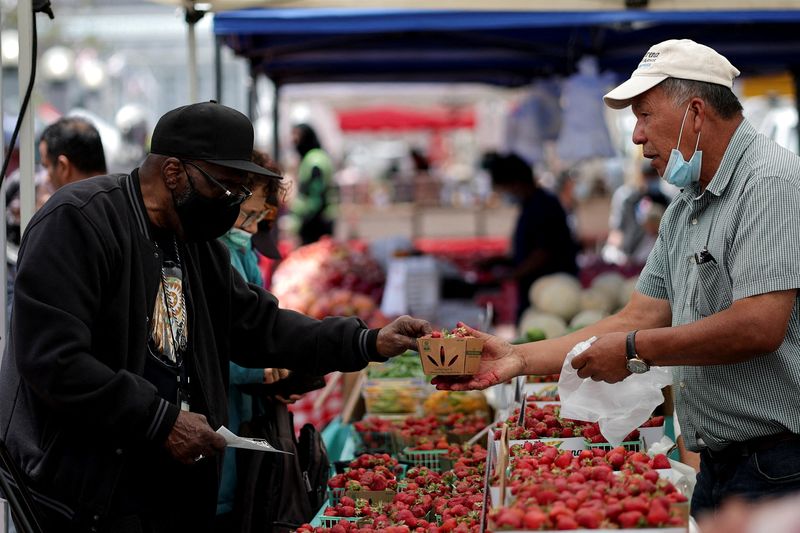US consumer prices rise moderately; underlying inflation strong
2023.06.13 09:55

© Reuters. A resident buys strawberries at a local market, in downtown San Francisco, California, U.S., July 13, 2022. REUTERS/Carlos Barria
By Lucia Mutikani
WASHINGTON (Reuters) – U.S. consumer prices barely rose in May and the annual increase in inflation was the smallest in more than two years, though underlying price pressures remained strong, supporting the view that the Federal Reserve would keep interest rates unchanged on Wednesday while adopting a hawkish posture.
The smaller-than-expected rise in the Consumer Price Index, reported by the Labor Department on Tuesday, reflected decreases in the costs of energy products and services, including gasoline and electricity. But rents remained sticky and prices of used cars and trucks rose further. The report was published as Fed officials prepared to gather for a two-day policy meeting.
“It would likely have taken a meaningful upside inflation surprise to convince the Fed to hike in June,” said Seema Shah, chief global strategist at Principal Asset Management. “Yet, with annual core inflation actually rising further in May and coming hot off the heels from the very strong jobs report, the July Fed meeting is very much live.”
The CPI increased 0.1% last month as gasoline prices fell. The CPI gained 0.4% in April. In the 12 months through May, the CPI climbed 4.0%. That was the smallest year-on-year increase since March 2021 and followed a 4.9% rise in April.
The annual CPI peaked at 9.1% in June 2022, which was the biggest increase since November 1981, and is subsiding as last year’s large rises drop out of the calculation.
Economists polled by Reuters had forecast the CPI would gain 0.2% last month and increase 4.1% on a year-on-year basis.
Data this month offered a mixed picture of the labor market, with nonfarm payrolls increasing solidly in May, but the unemployment rate rising to a seven-month high of 3.7% from a 53-year low of 3.4% in April.
Economists believe the gradual inflation and labor market slowdown gives the Fed room to skip an interest rate hike on Wednesday for the first time since March 2022 when the U.S. central bank embarked on its fastest monetary policy tightening campaign in more than 40 years.
The Fed, which has hiked its policy rate by 500 basis points in this tightening cycle, is expected to leave the door open to further rate increases.
U.S. stocks were set to open higher. The dollar fell against a basket of currencies. U.S. Treasury prices rose.
ECONOMIC SLOWDOWN
With the economy showing signs of slowing, economists argue the Fed should pause further rate increases while assessing the impact of the steps its has taken so far to cool demand.
Overall inflation is decelerating, thanks to energy and food costs. Food commodity prices have dropped back to levels seen prior to Russia’s invasion of Ukraine in February 2022.
Inflation is, however, proving to be sticky excluding these volatile categories, and remains well above the Fed’s 2% target.
The so-called core CPI increased 0.4% in May, rising by the same margin for the third straight month.
High rents continued to put upward pressure on the core CPI, with used cars and trucks also providing a boost. The rise in used cars and trucks reflects the delayed impact of increases during the winter and early spring.
Beyond May, however, core inflation is expected to slow, driven by a moderation in rents and resumption in price declines for used cars and trucks. The rental vacancy rate rose to a two-year high in the first quarter, while independent measures have been showing rents on a downward trend.
Rent measures in the CPI tend to lag the independent gauges by several months. In the 12 months through May, the core CPI climbed 5.3% after increasing 5.5% in April.








